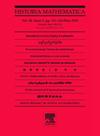一个非十进制位置数字系统的早期例子
IF 0.4
3区 哲学
Q3 HISTORY & PHILOSOPHY OF SCIENCE
引用次数: 0
摘要
非十进制数字系统的想法是在17世纪由几位数学家提出的,特别是托马斯·哈里奥特,戈特弗里德·威廉·莱布尼茨,胡安·卡拉梅尔·洛布维茨和埃哈德·魏格尔。早在16世纪末,德国数学家安东·舒尔茨就描述了以24为基数的数字系统,并展示了该系统的基本算术运算。舒尔茨在1584年出版的《商业算术》教科书中提到了一个例子,并在1600年出版的教科书的扩展版中进行了稍微修改。本文章由计算机程序翻译,如有差异,请以英文原文为准。
An early example of a nondecimal positional number system
The idea of nondecimal number systems was developed during the 17th century by several mathematicians, especially by Thomas Harriot, Gottfried Wilhelm Leibniz, Juan Caramuel y Lobkowitz and Erhard Weigel. Already at the end of the 16th century, a German mathematician Anton Schultze described the base-24 positional number system and showed the basic arithmetic operations in this system. Schultze did so in an example that he included in his textbook of commercial arithmetic published in 1584 and – in a slightly modified form – in an extended version of the textbook that appeared in 1600.
求助全文
通过发布文献求助,成功后即可免费获取论文全文。
去求助
来源期刊

Historia Mathematica
数学-科学史与科学哲学
CiteScore
1.10
自引率
0.00%
发文量
29
审稿时长
72 days
期刊介绍:
Historia Mathematica publishes historical scholarship on mathematics and its development in all cultures and time periods. In particular, the journal encourages informed studies on mathematicians and their work in historical context, on the histories of institutions and organizations supportive of the mathematical endeavor, on historiographical topics in the history of mathematics, and on the interrelations between mathematical ideas, science, and the broader culture.
 求助内容:
求助内容: 应助结果提醒方式:
应助结果提醒方式:


